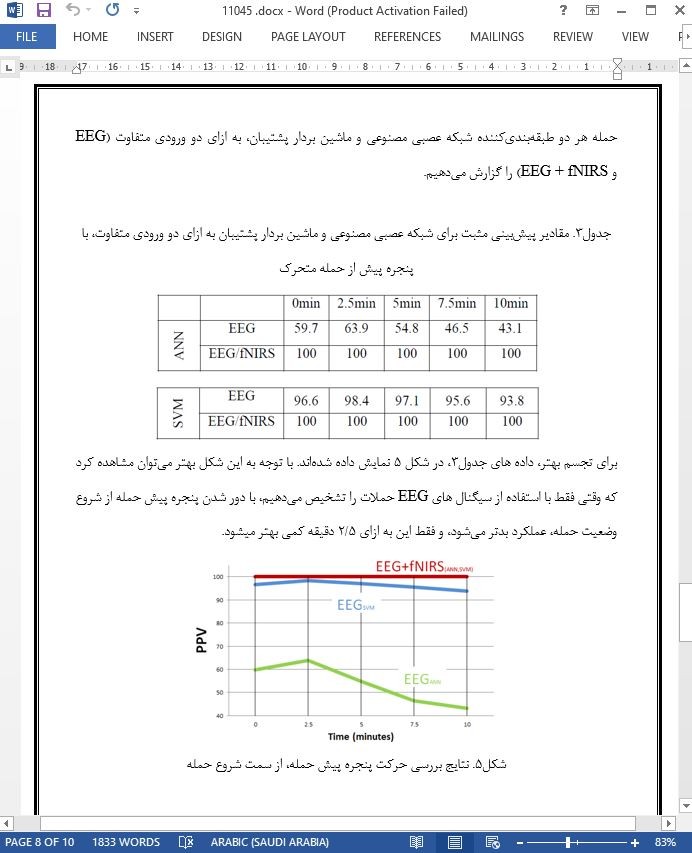
تشخیص زود هنگام حملات صرع با استفاده از ثبت نوری و الکتریکی
چکیده
این مقاله، نتایج ابتدایی در مورد تشخیص حمله صرعی ارائه میدهد. ترکیب روشهای طیفسنجی عملکردی نزدیک به مادون قرمز و الکتروآنسفالوگرام ، عملکرد بهتری نسبت به روش صرف EEG نشان میدهد. علاوهبراین، بعضی نتایجی که پیشبینی میکند میتوان حمله را تشخیص داد نیز ارائه شده است.
1) مقدمه
صرع جزء یکی از سه اختلال عصبی شایع است؛ این بیماری بعد از سکته مغزی و بیماری آلزایمر در رتبه سوم قرار دارد. تخمین زده شده 65 میلیون نفر در سراسر جهان که حدود 1% از جمعیت جهان را تشکیل میدهد، از صرع رنج میبرند. به طور متوسط سالانه 60 مورد جدید شامل 100 هزار نفر اضافه میشوند.
5) نتیجهگیری و کارهای آینده
اگر چه نتایج حاصل از مطالعه موردی قطعی نیست، اما جدول 2 نشان میدهد که افزودن ویژگیهای fNIRS به یک آشکارساز مبتنی بر EEG، عملکرد آن را به طور قابل توجهی بهبود می بخشد. علاوه براین براساس جدول 3 و شکل 5، تایید کردیم که اطلاعات موجود در fNIRS میتواند به تشخیص خیلی سریعتر حملات کمک کند. با توجه به این نتایج امیدوارکننده، پژوهشهای آتی ما در مورد بهکارگیری این روش بر روی طبقهبندیکنندههای دیگر و مجموعه دادههای بزرگتر خواهد بود. همچنین بر استخراج ویژگیهای جدیدتر و بهتر از سیگنالهای fNIRS تمرکز خواهیم کرد و آنها را با ویژگیهای استخراج شده از ثبت EEG ترکیب میکنیم. یکی از محدودیتهای کار ما، عدم استفاده از الگوریتم انتخاب ویژگی است که اگر چه با توجه به نتایج امیدوار کننده تنها بر اساس استخراج دامنه سیگنالها به عنوان ویژگی ممکن است مورد نیاز نباشد. در روش یادگیری ماشین ارائه شده، انتخاب پارامترهای بهینه مانند نوع هستهی ماشین بردار پشتیبان و پارامترهای مرتبط با آن، تعداد نورونها در لایه پنهان شبکه عصبی و همچنین فرآیند انتخاب ویژگی، در کار آتی بررسی خواهد شد.
Abstract
This paper presents preliminary results on epileptic seizure detection. Combination of functional Near Infrared Spectroscopy (fNIRS) and Electroencephalogram (EEG) recordings shows enhanced performance compare to EEG recordings alone. Moreover, some results concerning the anticipation at which a seizure can be detected are also presented.
I. INTRODUCTION
Epilepsy is one of the top three most common neurological disorders; it is just below strokes and Alzheimer disease [1]. It is estimated that 65 million people around the world suffer from epilepsy, which represents approximately 1% of the global population [2]. On average, 60 new cases of epilepsy 100,000 people emerge every year [2]–[4].
V. CONCLUSIONS AND FUTURE WORK
Even though results from a case-study are not conclusive, Table 2 suggests that adding fNIRS features to an EEG-based detector will considerably improve its performance. Furthermore, from Table 3 and Fig. 5 we confirmed that information contained within fNIRS can help to detect seizures much earlier. Given these promising results, our future work will be to try the same approach with others classifiers on a larger sample. We will also focus on extracting new and better classification features out of the fNIRS signals and combine them with features extracted from EEG recordings. One limitation of our work is the lack of implementation of a feature selection algorithm, although it may not be needed, given the promising results using only the amplitude of signals as features. The choice of optimal parameters in our machine learning approaches, such as SVM kernel type and its associated parameters, number of neurons in the ANN hidden layer as well as a feature selection process will be tackled in future work.

چکیده
1) مقدمه
2) ثبت EEG و fNIRS
3) روش
4) نتایج
5) نتیجهگیری و کارهای آینده
Abstract
I. INTRODUCTION
II. EEG AND FNIRS RECORDINGS
III. METHOD
IV. RESULTS
V. CONCLUSIONS AND FUTURE WORK
- اصل مقاله انگلیسی با فرمت ورد (word) با قابلیت ویرایش
- ترجمه فارسی مقاله با فرمت ورد (word) با قابلیت ویرایش، بدون آرم سایت ای ترجمه
- ترجمه فارسی مقاله با فرمت pdf، بدون آرم سایت ای ترجمه
